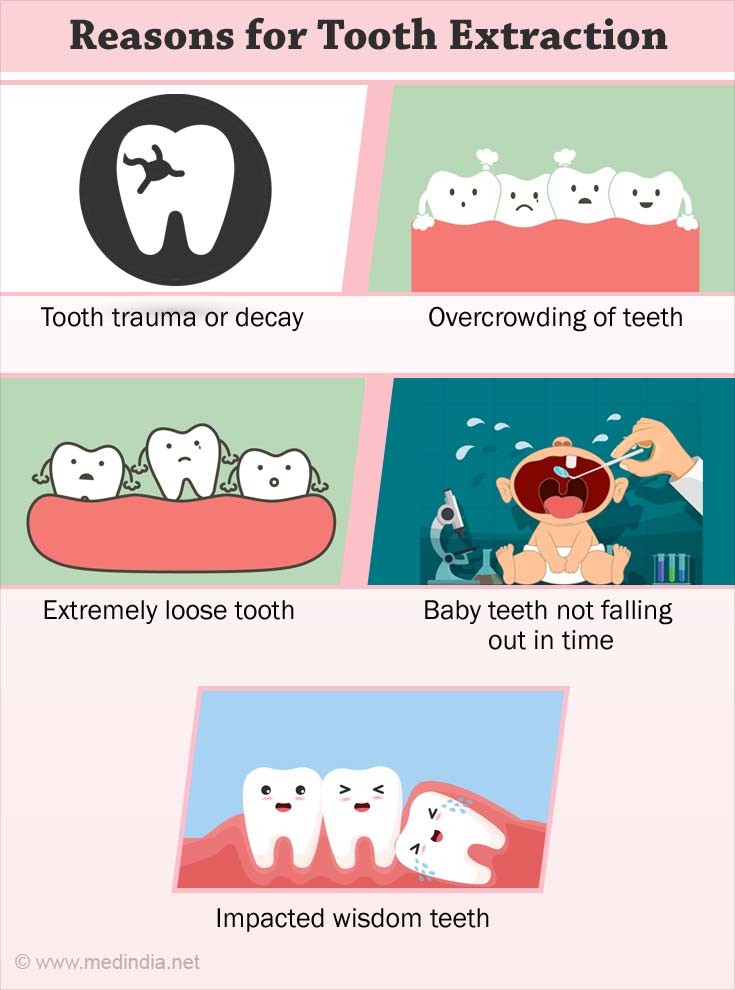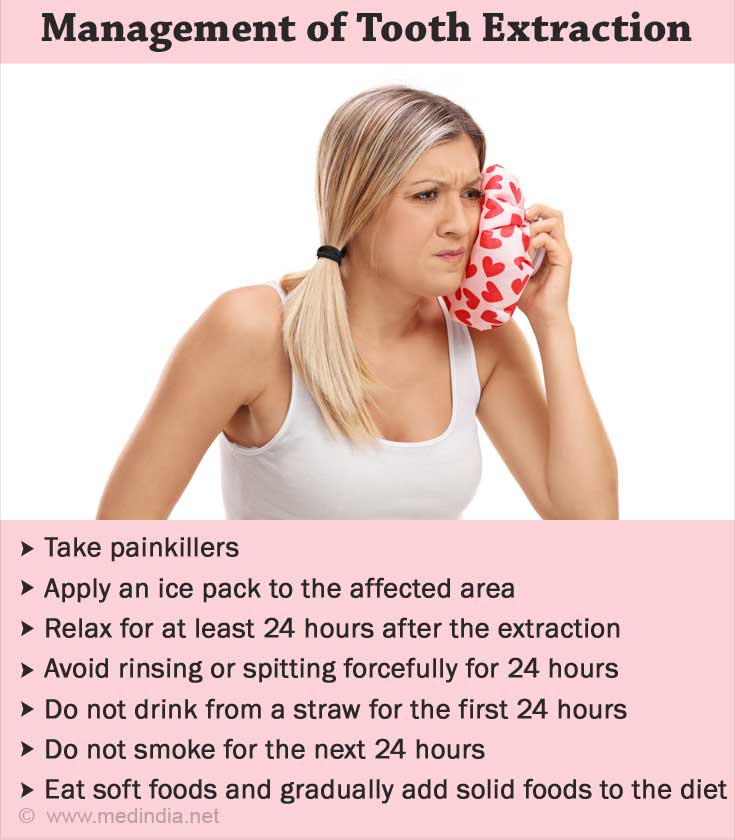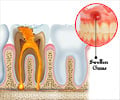- Tooth Extraction - (https://medlineplus.gov/ency/article/007630.htm)
- Your guide to having teeth removed - (https://www.england.nhs.uk/mids-east/wp-content/uploads/sites/7/2017/07/pt-info-leaflet-extractions.pdf)
- About Tooth Extraction - (https://www.gosh.nhs.uk/teenagers/tests-and-treatments/tooth-extraction/)
- Why would I need a tooth extracted? - (https://familydentalcareuk.co.uk/nhs-extractions)
What is Tooth Extraction?
Tooth extraction is the forced removal of a tooth from its bony socket present in the mouth. It is done manually by a dentist using tooth forceps in a dental clinic.
The first thing that comes to one’s mind when they think of tooth extraction is fear. It can be overcome by knowing about the pros and cons of the procedure in advance.
Reasons for Tooth Extraction
Tooth extraction is not always a recommended procedure in dentistry. It is performed in a complicated situation when the tooth cannot be saved.
The various reasons for tooth extraction include the following:

- A badly damaged tooth from trauma or decay
- Overcrowding of teeth in the mouth to provide room for braces treatment
- The tooth not able to erupt through the gum
- Extremely loose tooth
- Baby teeth not falling out in time
- Impacted wisdom teeth, which cause gum pain and swelling
- A patient requiring radiation to the head or neck may need to remove the teeth lying in the areas of radiation
How to Prepare for Tooth Extraction?
Before scheduling the procedure, the dentist will take the appropriate x-rays to know the position of the tooth with the surrounding bone and review the patient’s past medical history.
Dentist should also know about any medications, and vitamins, supplements, and over-the-counter drugs taken by the patient.
Although tooth extraction is very safe, the procedure can allow harmful bacteria into the bloodstream increasing the risk of infection.
Apart from this, other medical conditions put patients at high risk for developing a severe infection. The following are the risky medical conditions:
- Congenital heart defect
- Diabetes
- Liver disease
- Thyroid disease
- Kidney disease
- Hypertension
- Artificial joint
- Damaged heart valves
- Adrenal disease
- Impaired immune system
- Medical condition treated with bisphosphonate drug
If the following conditions are present, need to take antibiotics before and after the extraction.
Patients taking blood thinning medication should consult their physician first to avoid excess bleeding during tooth removal.
Based on this information, the dentist will determine the best way to remove the tooth.
Tooth Extraction Procedure
The tooth extraction process will be either simple or surgical, depending on whether the tooth is visible or covered by gums and bone.
Simple Extraction
The patient will receive a local anesthetic solution by injecting in the gum, which numbs the area around the tooth so that only pressure is felt during the procedure. The dentist then uses an instrument called an elevator to loosen the tooth and forceps to pull it out.
If a patient feels any pain during the procedure, they should notify their dentist immediately. The dentist will administer more numbing agents.
Surgical Extraction
It is a more complex procedure for a tooth that may have broken off at the gum line or has not yet come into the mouth. A specialist-like oral surgeon usually performs surgical extractions; however, general dentists can perform them as well.
The patient may receive both local anesthesia and intravenous anesthesia, the latter of which makes them calm and relaxed. General anesthesia is also given depending on the other medical conditions.
The general dentist or oral surgeon will cut into the gum with a small incision and may need to remove the bone around the tooth before it can be pulled out.
After the extraction, stitches may be necessary to control the bleeding. The dentist or surgeon will place a thick layer of gauze over the extraction site and have the person bite on it to absorb the blood.
Management of Tooth Extraction
Following an extraction, the dentist might ask the patient to bite down gently on a piece of dry, sterile gauze, and it should be kept in place for up to 30 to 45 minutes to limit bleeding,
Recovery typically takes a few days. The following steps can help minimize discomfort, reduce the risk of infection, and speed recovery.

- Take painkillers as prescribed by the dentist.
- Change gauze pads before they become soaked with blood.
- Apply an ice pack to the affected area immediately after the procedure to keep down swelling. Apply for 10 minutes at a time.
- Relax for at least 24 hours after the extraction. Limit activity for the next day or two.
- Avoid rinsing or spitting forcefully for 24 hours after the extraction to avoid dislodging the blood clot
- After 24 hours, rinse the mouth with a solution made of 1/2 teaspoon salt and 1 cup of warm water.
- Do not drink from a straw for the first 24 hours.
- Do not smoke for the next 24 hours.
- Eat soft foods, such as soup, pudding, or yogurt, the day after the extraction. Gradually add solid foods to the diet as the extraction site heals.
- When lying down, prop your head with pillows. Lying flat may prolong bleeding.
- Continue to brush and floss as usual after a tooth extraction, but avoid disturbing the blood clotting. Doing so will help to prevent infection.
Tooth Extraction Complications
Tooth extraction is a day care procedure that carries fewer complications than other surgical conditions but, rarely, it also causes certain life-threatening conditions like stroke or hypoxia (low oxygen in the tissues) that may be fatal. The complications of tooth extraction include -
- Severe pain, swelling, and residual bleeding for more than 4 hours after extraction.
- Dry socket—The bone in the extraction area is becoming exposed, either because of the dislodged blood clot; this condition is called a dry socket. It is one of the common complications. It can cause intense pain that usually starts a few days after the procedure and bad breath. Treatment will involve rinsing the area and placing medicinal paste on top of the exposed bone to protect it.
- Infection is another complication, and it can occur when bacteria infect the gum line in and around the extracted area within 1 to 2 days after surgery. The symptoms of infection are fever, persistent swelling, pus, redness in or around the extraction site, and swollen glands in the neck.
- Damage to nearby teeth.
- Incomplete removal of tooth.
- Stiffness and soreness in the jaw due to the injections and keeping the mouth open for too long.
Other potential complications include:
- Damage to the sinus during the removal of upper wisdom teeth.
- Fractured jaw (common among elderly people) due to the pressure exerted while extracting the tooth.
- Nerve injury during the lower teeth extraction causes temporary numbness for around 6 months or sometimes permanent numbness.
- Removing many teeth in the back of the jaw results in improper alignment of teeth, ultimately leading to cracked or dry lips.









